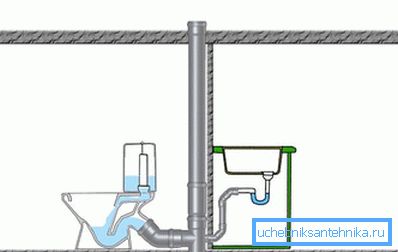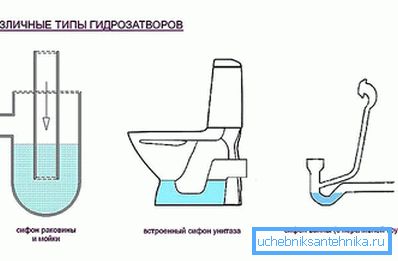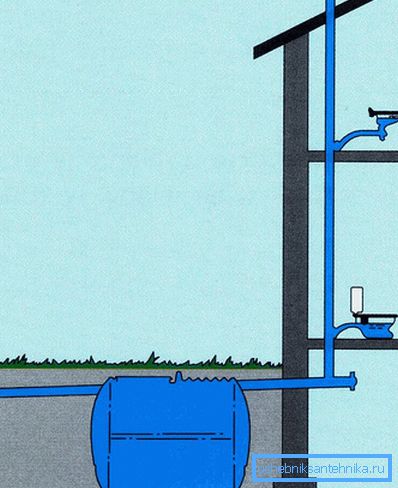Ventilation fan pipe
To prevent the ventilation system from delivering you a lot of trouble, you need to equip it with all the necessary fixtures and devices. One of these important components is the fun pipe. This element is responsible for much of which will be discussed in the article. We will also talk about how to ventilate the fun pipe.
What is a fan pipe for?

Such an element of the sewage system as a fan pipe is not always needed. According to current building codes, there is no need to install it when building a house on one or two floors. If the storey of the house is more than 2, then the funnel pipe must be installed necessarily.

In addition, this element of the sewer should be present if:
- in the house more than one bathroom or bathroom.
- when installing the riser of the sewage system, a pipe with a diameter of 50 mm or less is used.
- if there is a sanitary unit in the house that requires simultaneous discharge into the sewer of a large amount of water (for example, if the house has a pool).
Tip! Also the installation of this element is desirable if the house is equipped with an autonomous sewage system. For example, when sewage treatment is carried out using a septic tank, ventilation should be done using a funnel pipe.

And why do we need such ventilation? When draining the water in the sewage system, a discharged pressure is created. If the volume of simultaneously arriving drains is small, then the pressure difference is compensated by siphons (or rather, water in them). But with a large simultaneous descent, a vacuum is created in the pipes. As a result, the water from the siphon is sucked out, which opens the door to unpleasant odors.
In order to prevent the creation of a vacuum, it is necessary to ensure the flow of air from outside to equalize the pressure. It is for these purposes that the fan pipe is mounted. In addition, the traction does not allow the smell to enter the room, even if the water in the siphons dried out after a long non-use of the sewer system.
Device and Installation Tips

To improve the performance of the sewer system and protect themselves from the penetration of unpleasant odors, experts recommend installing fan ventilation even in single-story houses. The works themselves do not require special knowledge and skills and are completely feasible on their own. The system of fan ventilation itself consists of the following elements:
- The ventilation duct (it goes from the riser to the roof, the fan pipe will be placed there). Such an element should be provided at the stage of building a house. If it is not there, the withdrawal of fan ventilation may require from you a large financial and physical cost.
- Connecting pipes and fittings (they are necessary to connect to the sewer riser).
- The fun pipe itself.
When creating a ventilation system using a funnel pipe, you should observe the following recommendations from experts:
- The most important thing is that the diameter of the fan pipe be equal to the cross section of the riser. Also, experts recommend using the same type of materials (polymer or cast iron). If you don’t want to make a cast iron pipe (this material is quite heavy and difficult to install), then you need to use a rubber adapter as a connecting element.
- It is allowed to connect several fun pipes. At the same time it is necessary to use sewer plastic tees with an angle of 45 degrees.
- It is also allowed to change the direction of the fan pipe (using all the same tees). At the same time the place of change of the direction has to be above the highest sanitary unit.
- Some areas of fan ventilation can run horizontally. In this case, it is required to withstand a slight bias towards the exit of gases, it should be 0.02%.

Also, experts recommend to comply with the requirements that apply directly to the fan pipe itself. Among them are the main ones:
- When bringing the fan pipe to the roof, it is necessary to follow the recommendations for its height above the roof. This indicator should be in the range of 30 to 50 cm.
- When the house has an attic space that is used for residential purposes, the pipe should be raised to 3 meters.
- To prevent smells from the sewage system from entering the room through windows and a balcony, the distance from the pipe to these elements must be at least 4 meters.
- You should take care of the insulation of the riser or skip it through heated rooms.
- Since most often plastic pipes are used for arranging fan ventilation (due to ease of installation), they must be protected from mechanical impact. When posting pipes through floors and roofing, metal sleeves are used.
- If your house is equipped with a chimney system, then installing a fan pipe in the same ventilation duct is prohibited.
- To protect insects and small debris from entering the sewage system, you should equip the outlet of the pipe with a grid.
In some houses of a large area there may be several sanitary units located in different parts of the building. In this case, in order not to pile up the roof with numerous pipes, it is possible to combine all the risers into one fan ventilation, it is best to make connections in the attic. This is done using sewer tees of the same diameter as the pipe. Do not forget about the slope in the direction of the exit gases.
Errors in the creation of fan ventilation

Fan ventilation is a simple communication, everyone can handle it. But here, some owners of suburban real estate make mistakes. Here are the most common ones:
- Many owners of private homes find it difficult to wire a funnel pipe through the roof. In order not to bother with cutting the hole, installing a metal sleeve and fixing the pipe itself, they bring ventilation to the attic space. Such a system will not be able to effectively cope with its task. All gases from the sewage will accumulate in the attic, and then certainly penetrate into the house.
- Also, not wanting to bring the pipe to the roof, many owners install it on the outer wall. This design will contribute to the formation of large amounts of condensate.
- To increase the exhaust often mount a wind vane on the top of a funnel. Such an additional construction not only does not contribute to a greater burden, but more often prevents the outflow of gases from the sewage system. Also, vane will increase the formation of condensate, which will penetrate into the sewer. And in winter, the accumulated water can freeze and reduce the diameter of the pipe, and thus reduce cravings.
When displaying a funnel pipe on the roof, there is often an error in its location. The exit should not be located under the overhang. In this case, there is a high risk of cutting the pipe when snow or ice melts.
Septic ventilation

If your country house is equipped with an autonomous sewage system (a septic tank is installed), then it must also be equipped with ventilation. Even during the installation or construction of the sewage treatment plant, it is necessary to provide in its upper part an opening for the installation of the ventilation pipe.
As a rule, plastic pipes are used for these purposes. They are light and do not present difficulties during installation. A casing is attached to the hole in the lid of the septic tank; its section must be at least 100 mm.
The upper end of the ventilation should be taller than a man. In addition, the hole must be protected from the penetration of debris and insects. For this it is better to equip the output with a grid. It is also desirable to protect the ventilation from the ingress of rainwater, for this mount a protective cone.
Video
In this video, you will be explained how to install the riser pipe from a funnel pipe: